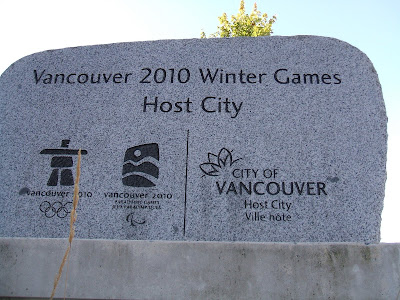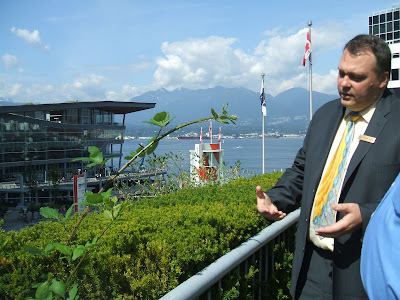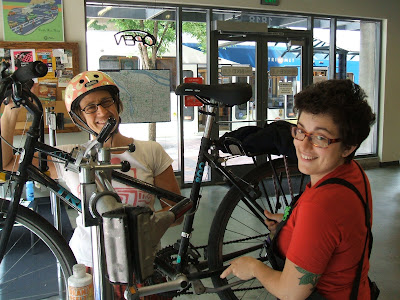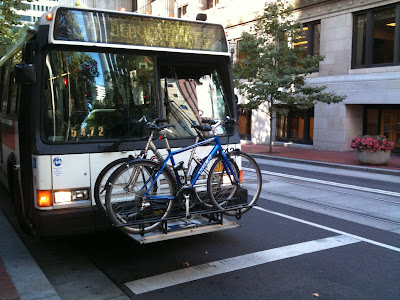Pacific Northwest Tour :
Seattle - Portland - Vancouver, BC
Seattle Aug 14-17/2011
Seattle seeks to become the most walkable city in the nation.
A walkable city is a place where people walk because walking is convenient, fun, and a healthy choice. People choose to walk to get to nearby places and to greet their neighbors. Walkable cities share common elements: - Enjoyable space to walk on every street, such as a walkway, a trail, or a shared space that invites walking;
- Well-maintained pedestrian facilities that are easy to navigate for all;
- Destinations within walking distance that allow people to live close to many different types of shops, schools, jobs, services, and parks;
- Walkable connections to transit to provide access to destinations that are beyond walking distance; and
- Places of respite that invite casual conversation, encourage connection with nature, and provide places to play.

The Green Tortoise Hostel
Sustainable Lodging - You Bet!
- High occupancy and shared facilities keep the prices as low as $26 per night.
- The communal atmosphere invites sharing of travel stories with many new and different people.
- Walking distance from all major downtown attractions eliminates need for car.
- Bikes are available for guests to check out anytime.
- Everything is recycled here.

Pike Place Public Market
Fresh, locally sourced produce, fish, & flowers.
Fresh, locally sourced produce, fish, & flowers.
Green Alternative Transporation
Electric Buses
Monorail and a Light Rail System
Zip Car Share Program:
w/ Locations Throughout the City
Bicycle "Pedi" Cabs
Bikes & More Bikes!
This is the best way to get around without stressing
over where to park.
Urban Hardwoods:
Sustainible Furniture Designs
Beautiful use of natural woods.
Knots, splits and imperfections are left in to give these pieces great character & handsome finish.
"Dr. Forgey's Power Desk" - $9500
Bill and Melinda Gates Foundation
LEED Gold Seattle Headquarters
Office buildings, grounds, and a state-of-the-art visitor center feature environmentally responsible design. The facility’s many green features include an underground concrete basin capable of holding a million gallons of rainwater, which will significantly reduce the facility’s dependence on the city water supply. Next door, a completed four-story parking garage has also received its LEED Gold certificate. The garage boasts a roof covered in sedum-spongy plants known for absorbing storm-water runoff. At 1.4 acres, it's the largest green roof in the city.
Washington State University Campus
Presentation on biofuels at Parrington Forum
Michael O'Hare (Professor of Public Policy, UC Berkeley).
A review of current controversies, and their implications for policy, regarding the increased use of biofuels (especially soybean diesel, sugar cane ethanol, and corn ethanol) to reduce the carbon footprint of transportation. Indirect effects (especially remote land use change), scientific and modeling uncertainty, the importance of discharge time profiles, and what we've learned about this surprisingly complex issue.
The Seattle Bike Port
a service provided by the Bicycle Alliance of Washington
(w/ support from City of Seattle, King County, Sound Transit)
24-hour, 7 day/week access to bicycle parking, restroom, and lockers with cardkey access.
Protection from vandalism and theft using security cameras and card key entry tracking.
Full service bicycle mechanic and retail shop on site.
24/7 access to a shop-stand, basic bike tools, and a vending machine stocked with emergency bicycle supplies.
Convenient nearby access to Metro Transit tunnel, Sounder and Amtrak train depots, Waterfront Shuttle, Washington State Ferries, and sport stadiums.
Local management provides prompt attention to any service needs.
Over the past year Seattle Bike Port's operational costs have risen, and they have seen a decrease in usage and a reduction in funding. After much consideration, it has been decided to close Seattle Bike Port as of December 31, 2011.
Cascade Bicycle Club
The Cascade Bicycle Club provides education programs and consulting services to the local community, in the interest of creating a better community through bicycling.They educate elected officials and agencies about building bicycle-friendly communities; teach safe cycling to kids and adults; promote bicycle commuting through individual and corporate programs;review transportation plans to ensure that the cycling voice is heard; and work with schools on fitness programs and Safe Routes to Schools. Programs and materials are free or low-cost.
Vancouver British Colombia, Canada
Aug 17-20/2011
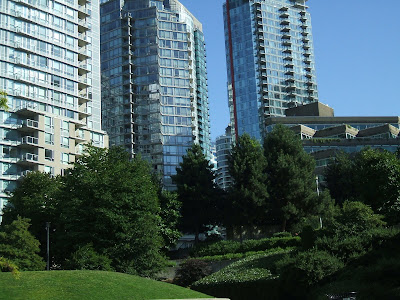
Vancouver Goes For The Gold!
All new development projects must be formally registered through the Canada Green Building Council (CaGBC) and achieve a minimum LEED Gold level.
A LEED scorecard is required at permit application and approved as condition of the development permit, This requirement applies to all medium and high density residential, mixed-use, commercial, institutional, and industrial developments.
Olympic Torch Structure Downtown
Vancouver created the Olympic Village in 2010
in the Southeast False Creek re-development area
This development now hosts mixed use, high density affordable housing. It bosts an environmentally-friendly community energy system that provides space heating and domestic hot water to all buildings in the development area.
Sustainable features include:
- "EcoDistrict" development principles: leveraging shared community heating.
- Urban agriculture
- Rainwater management systems with 50% reduction in water consumption
- Green roofs
- Island and inter-tidal fish habitat
- Seaside greenway and bikeway.
The Seawall is a 13.7 mile walking, jogging, cycling and inline skating path that lines Vancouver's waterfront from the convention centre on Burrard Inlet, around Stanley Park and False Creek, past Granville Island and ending at Kitsilano Beach Park. It is the most popular recreational facility in Vancouver.
Vancouver Green Drinks Meetup
Steamworks Brewing Co.
Green Drinks is a casual monthly gathering for anyone interested in sustainability issues.
Green Drinkers represent non-profit organizations, academia, government, small business, big business, self-employed, volunteers, students, concerned citizens...and everything in between.
Whether you're keen on green building & design, sustainable energy, organic gardening, or something else entirely, you'll find like-minded people.
Vancouver's Green Tranportation Options
All Prius Cab Fleets
Bikes Everywere
Electric Buses
"Sky Train" Light Rail
Car Share Program Citywide
Vancouver Area Cycling Coalition
The Vancouver Area Cycling Coalition (VACC) is a non-profit society whose goal is to make cycling an attractive choice for everyone. Through advocacy, education and events, the VACC is Metro Vancouver's bicycling resource.

Raema Quam, Director of Programs and Development
Fairmont Waterfront Hotel
Rooftop Garden and Bee Hives
Rooftop garden and hive tour conducted by Director of Housekeeping and resident Beekeeper, Graeme Evans. We learned about the hotel's leading sustainability practices. With over 60 varieties of herbs, edible blooms, fruits and vegetables benefiting from the work of the honeybees. The staff chefs harvest the freshest produce and honey for use with the hotel's restaurant and bar menus.
Vancouver's Bikeway System
The City of Vancouver now has more than 400 lane kilometres of on-and off-street bicycle routes, including 10 new bike lanes downtown. Bike routes may be on painted bike lanes, or street bikeways with traffic calming measures like the planters shown below.
As part of Vancouver's action to be the greenest city in the world, the City is exploring options to attract more people to cycling as a mode of transportation.
The experience of other cities suggests that the perception of safety is essential to attracting more people to cycling and that separated bike lanes are perceived to be safer and more satisfying for cyclists than cycling next to traffic. The City is moving forward with separated bike lanes on existing bike routes in the downtown to connect key destinations, such as the central business district.
Three types of physical separation have been used to separate cars from bikes: planters, parking, and medians. Each barrier type is being evaluated for its benefits for these and future separated bike lanes.
Cyclists must obey the bicycle signal when facing both bicycle signals and conventional traffic signals.
City of Vancouver Engineering Services:
Discussing the Bike Master Plan
with David Lewis and John Leung
The Engineering Service Building is LEED Gold
by city development standards.
Vancouver City Hall:
Office of Sustainability Mgr. David Ramslie
At the beginning of 2009, Mayor Gregor Robertson assembled the Greenest City Action Team and threw down an audacious and exciting challenge: to develop a plan to make Vancouver the greenest city in the world by 2020.
Here are Vancouver's 10 Green long range goals:
1. Gain international recognition as a mecca of green enterprise
2. Eliminate dependence on fossil fuels
3. Lead the world in green building design and construction.
4. Make walking, cycling, and public transit preferred transportation options
5. Create zero waste
6. Provide incomparable access to green spaces.
7. Achieve a small ecological footprint
8. Enjoy the best drinking water of any major city in the world
9. Breathe the cleanest air of any major city in the world
10. Become a global leader in urban food systems.
On September 27, 1888 Stanley Park was officially opened establishing the fledgling city's first official "greenspace".
Stanley Park is an evergreen oasis of 1,000 acres close to the downtown core. Its natural west coast atmosphere offers a back drop of majestic cedar, hemlock and fir trees. The park abounds in wildlife and its features appeal to the naturalist, the plant lover or one who would do nothing more than relax.
University of British Colombia
The greenest building in the world:
UBC Center for Interactive Research in Sustainability
Dedicated to research, collaboration and outreach that lead to workable solutions for the challenges of urban sustainability.
A Living Laboratory that will be the most innovative and high performance building in North America to demonstrate leading-edge research and develop sustainable design practices, products, systems and policies.
Wesbrook Masterplanned Sustainable Community on the UBC Campus
Sustainable principles include landscape design strategies to integrate a native planting palette, rain water detention and distribution with green roofs, rain gardens, permeable surfaces, creation of wildlife corridors and habitat spaces
The townhouses cluster around a central courtyard space so residents truly feel like they're living in an urban forest.
Storm water naturally falls, runs-off and infiltrates by using rain chains to direct storm water from the roofs into a system of open concrete channels or "tributaries" which feed to a central "creek" which runs through the middle of the courtyard and into rain gardens.
Zip and Modo Car shares are everywhere!
Owning your own vehicle is just not neccessary, & too costly.

Beaty Biodiversity Museum, UBC Campus
Green Works
Sustainable Building Supply Center
Sustainable Building Supply Center

The Hive
a Green Collaborative Think Tank
The HiVE is a dynamic home for organizations and individuals working in the sustainability and creativity sectors, and beyond. We provide a shared work space with a cafe-like studio culture that facilitates creativity, collaboration and social innovation. Members save money by sharing infrastructure and amenities like business equipment, telecommunications, receptionist, meeting spaces, event spaces, kitchen, lounge, etc.
Portland, OR
"The Bike Mecca"
Aug 20 - 25, 2011
Eastbank Esplanade's Largest floating bike and pedestrian path in the U.S.
First order of buisiness: Rent a Bike! :)
This Fuji hybrid commuter bike is just right for my four day study of Portland's Bike and Pedestrian Transportation Design
(Sylish Portland State U. Cycling Team cap not included in rental)
Bicycles as transportation is HUGE here
thanks to Portland bicycle advocate groups and support by the city transportation department.
I'm immediately struck by the many striped bike lanes &traffic markings. They are everywhere!
This is the counrtry's most expansive city bike and pedestrian network.
We met for a private bicycle tour of Portland lead by Nathan McNeil,
Researcher at Institute for the Bicycle and Pedestrian Innovation at Portland State University
My favorite Portland bike traffic sign! Ouch!
Warns cyclists of the light rail tracks in the street
(This guy should really try riding with the front wheel attached, it's much safer)
Bike racks or bike parking facilities are required by city code for all buildings & businesses.
Bike parking options range from:
Indoor Bike Garages
to unique & functional "art racks"
Bonus! The city will install a free bicycle rack on the sidewalk in front of your business if the location meets the minimum requirements.
Support and Self-Service networks are available to cyclists throughout the city:
Met with Portland State University Real Estate Program Director Gerard Mildner
Discussed the Masters in Real Estate Design Program (MRED)
We also got to see the new
Toyota Plug-In Hybrid
pilot program vehicles on campus!
These vehicles won't hit the market 'till next year 2012; but they are happy here in downtown Portland, being checked out & test driven on loooong half-day coffee runs I imagine :)
We also got to see the new
Toyota Plug-In Hybrid
pilot program vehicles on campus!
These vehicles won't hit the market 'till next year 2012; but they are happy here in downtown Portland, being checked out & test driven on loooong half-day coffee runs I imagine :)
Toyota is even testing it's not-yet-ready for mainstream electric RAV4 small SUV's.
Found these vehicles hiding out in the University
parking garage....
INDIGO @ Twelve West:
a LEED Platinum certified residential tower
Living roof and garden
Wind Turbines
Cascadia Green Building Council
and the Living Building Challenge:
Kelley Beamer Advocacy & Outreach Manager
Moving beyond the once revolutionary LEED scope of strategies and requirements for building green, Cascadia, the Northwest chapter of the U.S. Green Building Council's Living Building Challenge meets once unimagined sustainability standards in areas of Site, Water, Energy, Materials, Indoor Quality, Beauty and Inspiration and Process and Leadership. Using a guideline of 20 prerequisites, the initiative supports buildings as not only self-sustaining structures but as those that harmoniously give back more than they take from the environments in which they're built.
LEED - ND (New Development)
and EcoDistricts
LEED for Neighborhood Development recognizes development projects that successfully protect and enhance the overall health, natural environment, and quality of life of our communities. The certification system encourages smart growth and new urbanist best practices, promoting the location and design of neighborhoods that reduce vehicle miles traveled and communities where jobs and services are accessible by foot or public transit. It promotes more efficient energy and water use—especially important in urban areas where infrastructure is often overtaxed.
An EcoDistrict is defined as: “an integrated and resilient district or neighborhood that is resource efficient; captures, manages, and reuses a majority of energy, water, and waste on site; is home to a range of transportation options; provides a rich diversity of habitat and open space; and enhances community engagement and wellbeing”.
Supporting a local organic & bike-themed brewery;
The "HUB" - Hopworks Urban Brewery
(This counts for Green Study credit right?)
Coincidentally - I met and scheduled my next professional networking contact,
Jon Pheanis with MIG Design at the HUB!
We met the following day at his downtown offices to discuss
Active Transportation and Complete Streets planning and careers in the field.
MIG has experience in the development of sustainable and comprehensive park and recreation master plans that address park facilities, open space and trails, programs and services.
Jon Pheanis ,Urban Planner at MIG
Timo Forsberg and Scott Cohen
Tim and Scott are alternative city transportation employees who develop and promote several programs to increase ridership and safety in the local community.
Here are some of the various programs that they manage to get Portlanders out of their cars and on bikes:
Portland By Cycle
Rides and Classes offer information and a supportive setting for adults new to cycling or just getting back on the bike.
This campaign encourages you to use a bike more often - for fun, exercise, shopping, or even commuting to work.
Classes in Spring and Fall cover topics that everyone on a bike can appreciate, from the basics of starting out to maintenance, shopping by bike, riding through the rainy seasons and more.
Guided bike rides show you the best of Portland's neighborhoods and how to ride safely and confidently.
Women On Bikes program, a series of rides and clinics specifically designed to encourage more women to ride.
Get Lit! program distributes bike lights to needy area residents.
Portland Safe Routes to School is a partnership of the City of Portland, schools, neighborhoods, community organizations and agencies that advocates for and implements programs that make walking and biking around our neighborhoods and schools fun, easy, safe and healthy for all students and families while reducing reliance on cars
Portland Development Commission
Steven Shain
Urban renewal defined: a state-authorized, redevelopment and finance program designed to help communities improve and redevelop areas that are physically deteriorated, suffering economic stagnation, unsafe or poorly planned. PDC uses urban renewal as a tool to focus public attention and resources in blighted or underused areas to stimulate private investment and improve neighborhoods.
Pam Treece
Executive Director, Greater Portland Inc.

Greater Portland Inc is a private-public economic development initiative focused on increasing the vitality of the Portland-Vancouver metropolitan area. The organization pursues business growth through recruitment and retention programs implemented collaboratively with private and public resources. Greater Portland was founded on three main components: incisive, targeted research; dynamic marketing initiatives and outreach.
Kirk Slack
Oregon Community Wind, and Former Portland Transportation Mgr / Civil Engineer
Oregon Community Wind, and Former Portland Transportation Mgr / Civil Engineer

Alta Planning+Design
Specializes in creating active communities where bicycling and walking are safe, healthy, fun, and normal daily activities
Talked with Planner Mike Tresidder about developments in the field of Active Tranportation. He shared details of his professional training and career opportunities.
Mike is also a professor with the Bike and Pedestrain graduate transportation studies taught at PSU's Initiative for Bicycle and Pedestrian Innovation.
Housed in the Portland State University Center for Transportation Studies, The Initiative for Bicycle and Pedestrian Innovation is an exciting new center for research and learning that is focused on bicycle and pedestrian travel. IBPI’s aim is to advance bicycling and walking as integral elements of the transportation system in Oregon’s communities.
Mia Birk is the Chief Executive Officer and Principal at Alta Planning+Design . She co-founded the Initiative for Bicycle and Pedestrian Innovation in the College of Urban Studies. She was the City of Portland Bicycle Program Manager from 1993-99, where she led a period of rapid growth of Portland's bikeway network. As a consultant, she has been involved in hundreds of bicycle, pedestrian, trail, and greenway plans across North America. Mia has led numerous groundbreaking studies in the field of non-motorized transportation and is a co-founder of the Cities for Cycling project of the National Association for City Transportation Officials.
Ever approachable; Mia signed her autobiography for me!
I read Mia's book Joyride during my stay in Portland.
It documents her dynamic career as Bicycle Tranportation Coordinator of Portland, her political struggles and triumphs, & and her current consulting work with Alta Planning. Mia is a true pioneer and major mover in the field of active transportation.
I read Mia's book Joyride during my stay in Portland.
It documents her dynamic career as Bicycle Tranportation Coordinator of Portland, her political struggles and triumphs, & and her current consulting work with Alta Planning. Mia is a true pioneer and major mover in the field of active transportation.










































